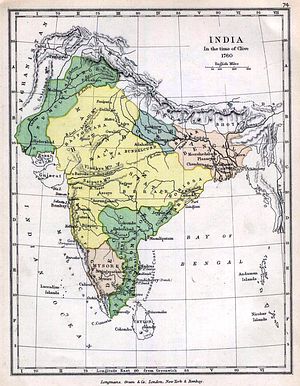British rule in South Asia began in Bengal between 1757 and 1765 as the British East India Company won battles, and was eventually given the legal right to collect revenue from that region by the powerless Mughal government. British power also expanded in South India, especially after their defeat of Tipu Sultan, the ruler of Mysore in 1799.
Yet the British did not become the dominant power in India until the conclusion of the Third Anglo-Maratha War, which took place between 1817 and 1818. It was only after that the settlement of 1818 that British ascendancy in India truly began.
The Hindu Maratha Empire was founded by the warrior Shivaji Bhonsle in 1674 in what is today the state of Maharashtra. Its power grew as bands of Marathas fought the Mughals, whose empire has grown weak after the death of Aurangzeb in 1707, and the Persian invasion of Nader Shah in 1739. The Marathas, moreover, utilized guerrilla tactics that proved to their advantage against large and divided Mughal armies. By the middle of the 18th century, the Marathas had emerged as the most powerful entity in India, and frequently allied with the British against South Indian states such as Hyderabad and Mysore, which were both closer to the French.
Even though the Maratha Empire lost the Third Battle of Panipat to the Afghans in 1761, it still remained the dominant power in India, and occupied Delhi from between 1770 to 1803, officially as the agents of the Mughal Empire, though in reality the converse was closer to the truth. In addition, the Marathas dominated much of the rest of India, including Odisha and the Rajput states.
It was during this time that the Maratha state became more of a confederacy than an empire, as its successful generals carved out new territories for themselves, and established dynasties, such as the Holkars and Sindhias, in addition to the peshwas, the title of the hereditary prime ministers who had become the de facto rulers of the empire during the course of the 18th century. It was these divisions between Maratha chiefs, as well as the competing ambitions of the Marathas and British, the region’s two greatest powers, that made war hard to avoid. Often, during a succession crisis among a Maratha family, one side or the other sought the help of the British, a circumstance the precipitated the First Anglo-Maratha War (1775-1782), which was largely inconclusive. However, the Marathas fared worse in the subsequent Second Anglo-Maratha War of 1803-1805.
Even in 1800, the Maratha Empire controlled most of western, central, and north India, and had a population estimated to be around 168,160,000, including territory it administered on the behalf of the Mughals, the greatest in the world after the Qing Empire of China; if it had acted in a strategic and united manner, it could have held its own in the subcontinent. In terms of military technology, it was not as a particular disadvantage, and moreover the British were preoccupied with fighting Napoleon. Nonetheless, the British were in a stronger position because of their ability to better monetize revenue from their now-substantive Indian territories, their perfecting of military drilling, and their ability to use divisions among their enemies to their advantage.
The Second Anglo-Maratha War was in fact “caused by the peshwa Baji Rao II’s defeat by the Holkars (one of the leading Maratha clans) and his acceptance of British protection by the Treaty of Bassein in December 1802.” The refusal of other Maratha rulers, including the Sindhias and the Bhonsles of Nagpur (a secondary branch of the still nominally ruling Maratha royal family descended from Shivaji), to accept British interference lead to war, and Maratha defeat. Delhi and most of north India passed into British hands in 1803, as well as the protectorate of the Mughal family, still nominally the rulers of much of India, a legal fiction that both the Maratha and British maintained.
In a sense, the final, Third Anglo-Maratha War was a clean-up operation, though until the war had concluded, the British were far from being the subcontinent’s paramount power. Initially, they entered Maratha territory to fight bandits known as pindaris, but ultimately came to fight several Maratha clans, including the peshwas, Bhonsles, and Holkars. The Sindhias, when threatened by war, instead signed a treaty with the British, becoming the princely state of Gwalior.
According to Percival Spear in The Oxford History of Modern India, 1740-1947, at this time, most other central and western Indian states previously tributary to the Marathas made subsidiary treaties with the British, including Bhopal, Jaipur, Udaipur, and Jodhpur. However, the territories ruled by the peshwas in western Maharashtra were annexed and became part of the Bombay Presidency, directly ruled by the British.
The Maratha polity ultimately had too many constituent components jostling for self-preservation for the state to hold together, especially when British protection seemed to provide more stability than the constant clashes of the main Maratha clans, however competent they were in commanding their own particular armies and fiefs. Moreover, many of the non-Maratha states under Maratha influence, such as the Rajput states, “were happy in their relief from Marathas and Pathans.” It remains interesting to speculate what would have become of the Maratha state had its component parts not had to deal with British interference.
As described by Spear, the settlement of 1818 led to the complete dominance of the British throughout India, except for the northwest where the Sikh Empire still thrived, leaving “the principal surviving Indians states… islands in a sea of British territory, or fenced in…” It “restored the unity of India to a degree more effective than had exited under the Mughals [due to the apparatus of a modern state and transportation], the main difference being….[that] as the Mughal power wrecked itself in trying to stretch to Cape Comorin [at the southernmost tip of India], the British power was to strain itself in trying to reach Kabul [formerly a Mughal stronghold].”

































